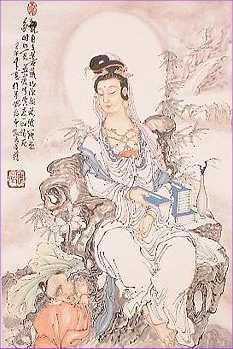
In many Buddhist temples, there will be images of the Bodhisattva Avalokitesvara
or popularly known as "Guan Shi Yin Pu'sa" (Guan-Yin for short). Most
images depict the Avalokitesvara as a benevolent woman clad in white robes,
holding a vase of pure water in one hand and a willow twig in the other. However,
the Avalokitesvara originated as a man. So how did this transformation of gender
come about?
In Buddhism, it is believed that all Bodhisattvas are asexual. They appear in
various forms in different circumstances. The Avalokitesvara for example, has
33 manifestations which will be listed out later.
Before the Avalokitesvara became a Bodhisattva, he was Prince Bu Xun and lived
in the Southern coast of India. After listening to Gautama Buddha's discourse,
he decided to renounce the material world to become a disciple of the Buddha.
Avalokitesvara was overcame by the suffering of all beings and made a great
vow of compassion to deliver them from further suffering.
In the Yuan Dynasty (1279-1368), a Lady Guan printed a "Biography of the
Goddess of Mercy", in which she claimed that the Bodhisattva Avalokitesvara
was a female. She and other women believed that there are certain tasks that
male Bodhisattvas were not 'fit' to perform, such as bestowing and delivering
babies. Choosing Avalokitesvara for this task was a shrewd and wise choice because
Avalokitesvara can transform into 33 manifestations, and a female was part of
the transformation. The trend caught on and soon many temples began erecting
images of a female Avalokitesvara. The most popular image of the Bodhisattva
is of a pretty woman wearing white robes, with kind eyes and jade-white smiling
face, wearing fringes with a bun done at the back of her head, a willow in her
right hand and a white vase in her left.
One of Avalokitesvara's appearances is of her with 1,000 hands and eyes. It
is one of Avalokitesvara's 33 transformations but a popular myth surrounds this
appearance. Legend has it that she was the 3rd daughter of Prince Zhuang of
Chu (722 B.C. - 481 B.C.) named Miao Shan. Miao Shan was a devoted Buddhist
who abstained from taking meat and chanted Buddhist sutras every day. When she
asked her father's permission to enter nunhood, he flew into a rage and had
her killed. Her soul was brought back by King Yama (Guardian of Hell) to a peaceful
place in the province of Zhejiang, where she could practice Buddhism without
interference. She attained Enlightenment and spent her days benevolently helping
human beings, relieving them of their distress.
One day Prince Zhuang fell seriously ill. Doctors told him that the only cure
for his illness was to rub an ointment made from the hands and eyes of a being
that was never angry. When Miao Shan heard this, she gouged out her own eyes
and cut her hands and made them into medicinal pills for her father. When the
prince got better, he was ashamed of his evil deeds and ordered that a statue
be made for Miao Shan. Through some miscommunication, the statue ended up having
1,000 eyes and hands.
According to the scriptures, Avalokitesvara was contemplating compassion for
the happiness and safety of all beings when he became so 'stressed' that his
head burst into 1,000 pieces. Amitabha Buddha (not to be confused with Gautama
Buddha) saw the situation and helped 'glue' back Avalokitesvara's head. He also
bestowed 11 heads, 1,000 eyes and 1,000 arms to the Bodhisattva so that he could
alleviate every being's suffering. That is why when people pray to Avalokitesvara
sincerely, He can come to each individual, even though they are at different
places at that time.
The 33 Manifestations of Avalokitesvara
According the scriptures, Avalokitesvara can transform into 33 incarnations
(depending on situations) and save beings from 13 types of disasters. The following
are the 33 manifestations of Avalokitesvara.
Avalokitesvara who holds the willow branch Avalokitesvara of the dragon head
Avalokitesvara who holds the sutras Avalokitesvara of complete light Avalokitesvara
of enjoyment or playfulness Avalokitesvara who wears white robes Avalokitesvara
who sits on a lotus leaf Avalokitesvara who views waterfalls Avalokitesvara
who gives medicine Avalokitesvara of the fish basket Avalokitesvara the King
of Merit Avalokitesvara of moon and water Avalokitesvara of the one leaf Avalokitesvara
of blue throat Avalokitesvara, powerful and virtuous Avalokitesvara who extends
life Avalokitesvara of various treasures Avalokitesvara of the rock cave Avalokitesvara
who bestows calmness Avalokitesvara of 1,000 hands and eyes Avalokitesvara of
fearlessness Avalokitesvara who wears robe of leaves (Parnashabari) Avalokitesvara
of Vaidurya Avalokitesvara of salvation Avalokitesvara of the clam Avalokitesvara
of 6 hours Avalokitesvara of universal compassion Avalokitesvara of Ma-Lang's
wife Avalokitesvara of prayer Avalokitesvara of Oneness Avalokitesvara of non-duality
Avalokitesvara holding the lotus Avalokitesvara of pure water
Bits and Pieces
The Avalokitesvara Mantra is 'Om Mani Padme Hum'. It contains 6 syllabus. Each
syllable represents each of the 6 realms in the world of Samsara (Deva, Semi
deva, Humans, Animals, Hungry Ghosts or Petas and Hell). When a being from any
of the 6 realms hears this mantra, it will immediately cast away all angry thoughts
and be enlightened.
The vase held by Avalokitesvara contains 'Amrita', meaning the Dew of Compassion.
It can purify the defilements of our body, speech and mind. It also contains
curative powers and can extend life.